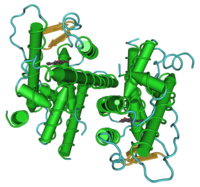Estrogen receptor
| estrogen receptor 1 (ER-alpha) | |
|---|---|

|
|
| Identifiers | |
| Symbol | ESR1 |
| Alt. symbols | ER-α, NR3A1 |
| Entrez | 2099 |
| HUGO | 3467 |
| OMIM | 133430 |
| PDB | 1ERE |
| RefSeq | NM_000125 |
| UniProt | P03372 |
| Other data | |
| Locus | Chr. 6 q24-q27 |
| estrogen receptor 2 (ER-beta) | |
|---|---|

|
|
| Identifiers | |
| Symbol | ESR2 |
| Alt. symbols | ER-β, NR3A2 |
| Entrez | 2100 |
| HUGO | 3468 |
| OMIM | 601663 |
| PDB | 1QKM |
| RefSeq | NM_001040275 |
| UniProt | Q92731 |
| Other data | |
| Locus | Chr. 14 q21-q22 |
| Estrogen receptor alpha N-terminal AF1 domain |
|||||||||
|---|---|---|---|---|---|---|---|---|---|
| Identifiers | |||||||||
| Symbol | Oest_recep | ||||||||
| Pfam | PF02159 | ||||||||
| InterPro | IPR001292 | ||||||||
| SCOP | 1hcp | ||||||||
| SUPERFAMILY | 1hcp | ||||||||
|
|||||||||
| Available protein structures: | |
|---|---|
| Pfam | structures |
| PDB | RCSB PDB; PDBe; PDBj |
| PDBsum | structure summary |
| Estrogen and estrogen related receptor C-terminal domain | |||||||||
|---|---|---|---|---|---|---|---|---|---|
| Identifiers | |||||||||
| Symbol | ESR1_C | ||||||||
| Pfam | PF12743 | ||||||||
|
|||||||||
| Available protein structures: | |
|---|---|
| Pfam | structures |
| PDB | RCSB PDB; PDBe; PDBj |
| PDBsum | structure summary |
Estrogen receptors (ERs) are a group of proteins found inside and on cells. They are receptors that are activated by the hormone estrogen (17β-estradiol). Two classes of ER exist: nuclear estrogen receptors (ERα and ERβ), which are members of the nuclear receptor family of intracellular receptors, and membrane estrogen receptors (mERs) (GPER (GPR30), ER-X, and Gq-mER), which are mostly G protein-coupled receptors. This article refers to the former (ER).
Once activated by estrogen, the ER is able to translocate into the nucleus and bind to DNA to regulate the activity of different genes (i.e. it is a DNA-binding transcription factor). However, it also has additional functions independent of DNA binding.
As hormone receptors for sex steroids (steroid hormone receptors), ERs, androgen receptors (ARs), and progesterone receptors (PRs) are important in sexual maturation and gestation.
There are two different forms of the estrogen receptor, usually referred to as α and β, each encoded by a separate gene (ESR1 and ESR2, respectively). Hormone-activated estrogen receptors form dimers, and, since the two forms are coexpressed in many cell types, the receptors may form ERα (αα) or ERβ (ββ) homodimers or ERαβ (αβ) heterodimers. Estrogen receptor alpha and beta show significant overall sequence homology, and both are composed of five domains designated A/B through F (listed from the N- to C-terminus; amino acid sequence numbers refer to human ER).
...
Wikipedia
